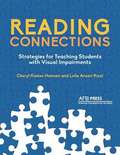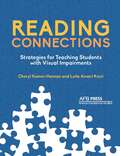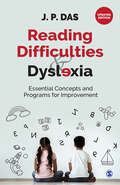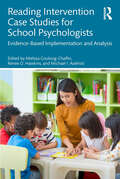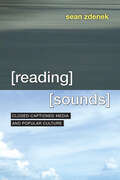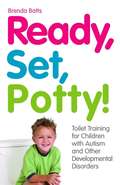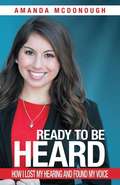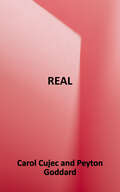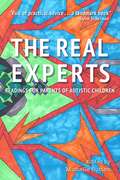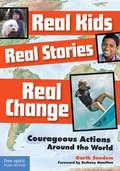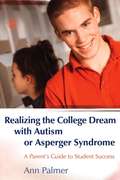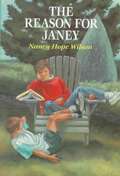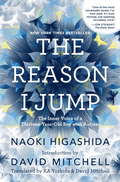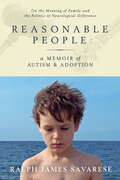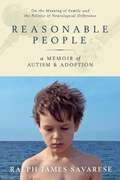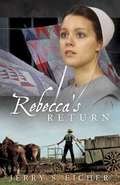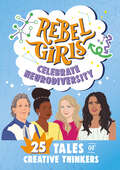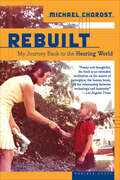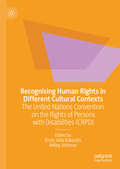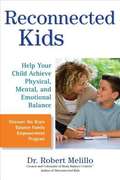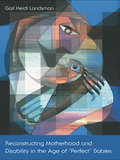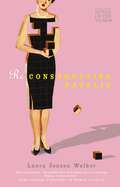- Table View
- List View
Reading Connections: Strategies For Teaching Students With Visual Impairments
by Cheryl Kamei-HannanReading Connections: Strategies for Teaching Students with Visual Impairments offers an in-depth and user-friendly guide for understanding reading instruction for teachers and professionals seeking to improve the reading skills of their students who are visually impaired. The book addresses in detail the essential components of reading--phonemic awareness, phonics, reading fluency, vocabulary, and reading comprehension--as well as other key reading components and subskills. While this book addresses the needs of students who read print, braille, or both, much of the book is also consistent with strategies for teaching reading to students who have, or are at risk for, developing reading disabilities. Teachers of students with visual impairments, as well as family members and other professionals who work with children who are blind or visually impaired, will find within this book a repertoire of strategies and activities for creating a balanced, comprehensive plan of reading instruction for each student and for teaching the essential reading skills necessary for students' success.
Reading Connections
by Cheryl Kamei-Hannan Leila Ansari RicciReading Connections: Strategies for Teaching Students with Visual Impairments offers an in-depth and user-friendly guide for understanding reading instruction for teachers and professionals seeking to improve the reading skills of their students who are visually impaired. The book addresses in detail the essential components of reading--phonemic awareness, phonics, reading fluency, vocabulary, and reading comprehension--as well as other key reading components and subskills. While this book addresses the needs of students who read print, braille, or both, much of the book is also consistent with strategies for teaching reading to students who have, or are at risk for, developing reading disabilities. Teachers of students with visual impairments, as well as family members and other professionals who work with children who are blind or visually impaired, will find within this book a repertoire of strategies and activities for creating a balanced, comprehensive plan of reading instruction for each student and for teaching the essential reading skills necessary for students' success.
Reading Difficulties and Dyslexia: Essential Concepts and Programs for Improvement
by J.P. DasPreviously, dyslexia was defined as primarily a deficit at the word reading level. When the original edition of this book was published, the core deficit was thought to be phonological coding. The search for a single factor for dyslexia is no longer pursued. However, we must explore why approximately 15 per cent of school children have difficulties in learning to read or doing math. This updated edition offers an explanation based on contemporary developments in the study of cognition and neuroscience. It also studies the impact of poverty on learning, a relatively new but extremely important area of interest. Going beyond a simple view of reading and math, Reading Difficulties and Dyslexia discusses distal factors such as cognitive flexibility and attentional control. A distinguishing feature of this book is that it presents intervention programmes, based on the distal factors, which can greatly improve word decoding and comprehension, and enhance number sense.
Reading Intervention Case Studies for School Psychologists: Evidence-Based Implementation and Analysis
by Melissa Coolong-Chaffin Renee O. Hawkins Michael I. AxelrodReading Intervention Case Studies for School Psychologists provides vivid, real-world examples of school-based interventions targeting students’ phonological awareness, phonics, fluency, and comprehension in reading. This book offers a rich variety of applied reading interventions in school settings , spanning strategies such as incidental teaching, word boxes, peer tutoring, taped words, story mapping, and beyond. Each case includes thorough descriptions of the specific area of concern, detailed intervention protocols, data collection and analysis methods, and tips for ensuring social acceptability and treatment integrity. School psychologists, along with related professionals in special education, general education, and speech-language pathology, will come away with new insights into this comprehensive set of well-researched and frequently applied reading interventions.
Reading Sounds: Closed-Captioned Media and Popular Culture
by Sean ZdenekImagine a common movie scene: a hero confronts a villain. Captioning such a moment would at first glance seem as basic as transcribing the dialogue. But consider the choices involved: How do you convey the sarcasm in a comeback? Do you include a henchman's muttering in the background? Does the villain emit a scream, a grunt, or a howl as he goes down? And how do you note a gunshot without spoiling the scene? These are the choices closed captioners face every day. Captioners must decide whether and how to describe background noises, accents, laughter, musical cues, and even silences. When captioners describe a sound--or choose to ignore it--they are applying their own subjective interpretations to otherwise objective noises, creating meaning that does not necessarily exist in the soundtrack or the script. Reading Sounds looks at closed-captioning as a potent source of meaning in rhetorical analysis. Through nine engrossing chapters, Sean Zdenek demonstrates how the choices captioners make affect the way deaf and hard of hearing viewers experience media. He draws on hundreds of real-life examples, as well as interviews with both professional captioners and regular viewers of closed captioning. Zdenek's analysis is an engrossing look at how we make the audible visible, one that proves that better standards for closed captioning create a better entertainment experience for all viewers.
Ready, Set, Potty!
by Brenda BattsPotty training a child with developmental disorders can be a real challenge, and sometimes the extra difficulties make you feel as though you've tried everything, and failed. In this book, Brenda Batts shows how you can overcome problems, big and small, and provides tried and tested methods that really work, tailored to each individual child. Bursting with ideas on how to see past conventional strategies and adapt toilet training to suit your child, this book outlines methods that have helped even the most despairing of parents and caregivers. Examples of success stories range from two-year-olds to adults aged 20, and show that no matter how difficult it may seem, a little creativity and adaptation can get anyone toilet trained, however many previous attempts have failed. The program itself is supported by plenty of helpful hints and tips, as Brenda covers all you need to get your child past the diaper stage and help them to achieve a big step towards independence. This book is a must for anybody looking to toilet train someone with developmental disorders.
Ready To Be Heard: How I Lost My Hearing And Found My Voice
by Amanda McDonoughWhen author Amanda McDonough started losing her hearing at the age of 4 she swore her parents to secrecy. She hid her hearing loss for 18 years from her friends, family, teachers, and acquaintances. As the author grew older, her hearing gradually decreased, causing her to begin struggling in school, in her relationships with family and friends, and with her identity. By age twenty-two, she could no longer rely on her wit to hide her hearing loss. She became one hundred percent deaf in both ears. Amanda found herself unable to hear, talk, lip-read or sign. Her only method of communication with the world was through writing. Ready to be Heard is the story of how Amanda taught herself to speak again, to lip-read, and to sign. McDonough explains how she discovered a new culture, language, and most importantly, herself. In this memoir, the author narrates how she managed to finish college after becoming deaf. How she garnered straight As in school, entered the workforce, enjoyed a successful Hollywood acting career (Freeforms Switched at Birth, ABCs Speechless, NBCs Bad Judge, Google, 7UP, Deaf West/ Pasadena Playhouses Our Town, etc.), fought for her independence, and found her purpose. Ready to be Heard tells about the authors journey to find a balance between the hearing world she was raised in and the Deaf culture to which she now belonged.
Real
by Carol Cujec Peyton Goddard"Sometimes Charity cannot control her body and because she has low-functioning autism, Charity cannot communicate her thoughts to anyone else, even though she feels all of the frustrations, fears, and doubts of a typical thirteen-year-old."
The Real Experts: Readings for Parents of Autistic Children
by Michelle SuttonListening to the insights and experiences shared by autistic bloggers has helped Michelle Sutton to help her two autistic children to thrive. Now, Michelle has collected writings from a dozen autistic authors. The result is an extraordinary resource for families with autistic children, and also for educators, therapists, and other professionals.
Real Kids, Real Stories, Real Change: Courageous Actions around the World
by Garth SundemEleven-year-old Tilly saved lives in Thailand by warning people that a tsunami was coming. Fifteen-year-old Malika fought against segregation in her Alabama town. Ten-year-old Jean-Dominic won a battle against pesticides--and the cancer they caused in his body. Six-year-old Ryan raised $800,000 to drill water wells in Africa. And twelve-year-old Haruka invented a new environmentally friendly way to scoop dog poop. With the right role models, any child can be a hero. Thirty true stories profile kids who used their heads, their hearts, their courage, and sometimes their stubbornness to help others and do extraordinary things. As young readers meet these boys and girls from around the world, they may wonder, "What kind of hero lives inside of me?"
Realizing the College Dream with Autism or Asperger Syndrome: A Parent's Guide to Student Success
by Ann PalmerRealizing the College Dream with Autism or Asperger Syndrome is both a practical and a personal account of one ASD student's successful experience of going to college. This accessible book focuses on how to get there and stay there: deciding to go, how to get in and how to get the most out of it. Ann Palmer advises parents and professionals how to prepare the student for the transition from school and home life to a new environment and educational challenge, and how to support them through potential problems such as academic pressure, living away from home, social integration and appropriate levels of participation in college. She offers helpful strategies that will encourage and inspire parents and students and show that college can be a suitable option for students with an autism spectrum disorder, as well as the basis for a successful independent life later. This book is essential reading for any parent considering college as an option for their child, disability service providers in colleges and for ASD students themselves.
Realizing the College Dream with Autism or Asperger Syndrome: A Parent's Guide to Student Success
by Ann PalmerRealizing the College Dream with Autism or Asperger Syndrome is both a practical and a personal account of one ASD student's successful experience of going to college.This accessible book focuses on how to get there and stay there: deciding to go, how to get in and how to get the most out of it. Ann Palmer advises parents and professionals how to prepare the student for the transition from school and home life to a new environment and educational challenge, and how to support them through potential problems such as academic pressure, living away from home, social integration and appropriate levels of participation in college. She offers helpful strategies that will encourage and inspire parents and students and show that college can be a suitable option for students with an autism spectrum disorder, as well as the basis for a successful independent life later.This book is essential reading for any parent considering college as an option for their child, disability service providers in colleges and for ASD students themselves.
Really Useful ASD Transition Pack
by Alis HawkinsUsing snippets of practice-based theory, this title provides an overview of considerations as diverse as sensory sensitivities and their impact on the school day, how interactions in the playground might be handled and whether the pupil is allowed to eat separately, as well as teaching and learning issues.
The Reason for Janey
by Nancy Hope WilsonPhilly’s life changes greatly when, after her parents' divorce, her mother takes in Janey, a retarded adult, to live with them. "I like to know the reasons for things,” says Philura Higley Mason. “When I know the reason for something, it fits. I can manage it.” She especially wants to know why Janey, a mentally retarded woman who moved in four months ago, fits into the family better than Dad, who moved out three years ago. After all, what makes a family a family? Last year, Philly won first prize at the fifth-grade science fair, so this year, superbrain Danny Stapleton is determined to outdo her. But Philly can’t even choose a topic. She’s wondering instead about Janey--that little-girl locket she wears, that mismatched pack of cards she carries, and that place she lived that makes Mom strangely angry: the Morrisville State School for the Mentally Retarded. And when Janey’s mother died, what happened to her father? As Philly uncovers Janey’s past, she unexpectedly collides with her own. Suddenly she must confront new truths about Dad, about Mom, and about herself. (She even makes some discoveries about Danny Stapleton.) The author of Bringing Nettie Back (also Macmillan U.S.A.) has artfully interwoven such complex issues as divorce, mental retardation, keeping secrets, and what it really means to be a family.
The Reason I Jump: The Inner Voice Of A Thirteen-year-old Boy With Autism
by David Mitchell Naoki Higashida Ka YoshidaYou've never read a book like The Reason I Jump. Written by Naoki Higashida, a very smart, very self-aware, and very charming thirteen-year-old boy with autism, it is a one-of-a-kind memoir that demonstrates how an autistic mind thinks, feels, perceives, and responds in ways few of us can imagine. Parents and family members who never thought they could get inside the head of their autistic loved one at last have a way to break through to the curious, subtle, and complex life within. <p><p> Using an alphabet grid to painstakingly construct words, sentences, and thoughts that he is unable to speak out loud, Naoki answers even the most delicate questions that people want to know. Questions such as: "Why do people with autism talk so loudly and weirdly?" "Why do you line up your toy cars and blocks?" "Why don't you make eye contact when you're talking?" and "What's the reason you jump?" (Naoki's answer: "When I'm jumping, it's as if my feelings are going upward to the sky.") With disarming honesty and a generous heart, Naoki shares his unique point of view on not only autism but life itself. His insights--into the mystery of words, the wonders of laughter, and the elusiveness of memory--are so startling, so strange, and so powerful that you will never look at the world the same way again. <p> In his introduction, bestselling novelist David Mitchell writes that Naoki's words allowed him to feel, for the first time, as if his own autistic child was explaining what was happening in his mind. "It is no exaggeration to say that The Reason I Jump allowed me to round a corner in our relationship." This translation was a labor of love by David and his wife, KA Yoshida, so they'd be able to share that feeling with friends, the wider autism community, and beyond. Naoki's book, in its beauty, truthfulness, and simplicity, is a gift to be shared.
Reasonable People: A Memoir of Autism and Adoption
by Ralph James SavareseWatch an interview with DJ on CNNListen to Ralph Savarese's interview on NPR's "The Diane Rehm Show"Visit the book's website: www.reasonable-people.com"Why would someone adopt a badly abused, nonspeaking, six-year-old from foster care?" So the author was asked at the outset of his adoption-as-a-first-resort adventure. Part love story, part political manifesto about "living with conviction in a cynical time," the memoir traces the development of DJ, a boy written off as profoundly retarded and now, six years later, earning all "A's" at a regular school. Neither a typical saga of autism nor simply a challenge to expert opinion, Reasonable People illuminates the belated emergence of a self in language. And it does so using DJ's own words, expressed through the once discredited but now resurgent technique of facilitated communication. In this emotional page-turner, DJ reconnects with the sister from whom he was separated, begins to type independently, and explores his experience of disability, poverty, abandonment, and sexual abuse. "Try to remember my life," he says on his talking computer, and remember he does in the most extraordinarily perceptive and lyrical way.Asking difficult questions about the nature of family, the demise of social obligation, and the meaning of neurological difference, Savarese argues for a reasonable commitment to human possibility and caring.
Reasonable People: A Memoir Of Autism And Adoption
by Ralph James SavareseWatch an interview with DJ on CNN Listen to Ralph Savarese's interview on NPR's "The Diane Rehm Show" Visit the book's website: www. reasonable-people. com "Why would someone adopt a badly abused, nonspeaking, six-year-old from foster care?" So the author was asked at the outset of his adoption-as-a-first-resort adventure. Part love story, part political manifesto about "living with conviction in a cynical time," the memoir traces the development of DJ, a boy written off as profoundly retarded and now, six years later, earning all "A's" at a regular school. Neither a typical saga of autism nor simply a challenge to expert opinion, Reasonable People illuminates the belated emergence of a self in language. And it does so using DJ's own words, expressed through the once discredited but now resurgent technique of facilitated communication. In this emotional page-turner, DJ reconnects with the sister from whom he was separated, begins to type independently, and explores his experience of disability, poverty, abandonment, and sexual abuse. "Try to remember my life," he says on his talking computer, and remember he does in the most extraordinarily perceptive and lyrical way. Asking difficult questions about the nature of family, the demise of social obligation, and the meaning of neurological difference, Savarese argues for a reasonable commitment to human possibility and caring.
Rebecca's Return (The Adams County Series #2)
by Jerry S. EicherThe author, Jerry S. Eicher, continues the plot he began in Rebecca's Promise, Book 1 of the Adams County Trilogy. In Rebecca's Return, Book 2 of the Trilogy, the young Amish woman Rebecca Keim returns to Wheat Ridge full of resolve to make her relationship with John Miller work. But in her absence, John has become suspicious of Rebecca. Does she still love someone else? Before she can find peace with the past, John is caught up in a crisis of his own. Events spin out of control, and Rebecca is left to deal with the pieces. What is God's will for this couple, and is there any hope for the recovery of their love?
Rebel Girls Celebrate Neurodiversity: 25 Tales of Creative Thinkers (Rebel Girls Minis)
by Rebel GirlsTRUE STORIES OF NEURODIVERGENT ICONSThis collection features 25 inspiring tales of neurodivergent artists, athletes, innovators, and more. Read about how these women and girls thought creatively, achieved their dreams, and advocated for the rights of neurodivergent people everywhere.Walk the runway with Madeline Stuart, the first professional model with Down syndrome. Steal the scene with Salma Hayek, the award-winning actor with dyslexia. Learn how journalist and TV host Lisa Ling thrives with ADD, and how Temple Grandin&’s autism has opened up new and compassionate ways of interacting with animals.This book pairs inspiring, easy-to-read text with colorful full-page portraits created by female and nonbinary artists from all around the world. Plus, scannable codes let you listen to longer stories on the Rebel Girls app!
Rebuilt: My Journey Back to the Hearing World
by Michael ChorostAfter Michael Chorost suddenly lost what was left of his hearing, he took the radical step of having a cochlear implant -- a tiny computer -- installed in his head. A technological marvel, the device not only restored to him the world of sound but also could be routinely upgraded with new software. Despite his intitial fear of the technology's potentially dehumanizing effects, Chorost's implant allowed him to connect with others in surprising ways: as a cyborg, he learned about love, joined a writing group, and formed deeper friendships. More profoundly, his perception of the world around him was dramatically altered. Brimming with insight and written with charm and self-deprecating humor, Rebuilt unveils, in personal terms, the astounding possibilities of a new technological age.
Recognising Human Rights in Different Cultural Contexts: The United Nations Convention on the Rights of Persons with Disabilities (CRPD)
by Kelley Johnson Emily Julia KakoullisThis book explores the journey of the United Nations Convention on the Rights of Persons with Disabilities (CRPD) as it is interpreted and translated from International Human Rights Law into domestic law and policy in different cultural contexts. Beginning with reflections on ‘culture’, ‘disability’ and ‘human rights’ from different disciplinary perspectives, the work is then organised as ‘snapshots’ of the journey of the CRPD from the international level to the domestic; the process of ratification, the process of implementation, and then the process of monitoring the CRPD’s implementation in States Parties cultural contexts. Leading global contributors provide cutting-edge accounts of the interactions between the CRPD and diverse cultures, revealing variations in the way that the concept of ‘culture’ is defined. This collection will appeal to academics and students in Law and Socio-Legal Studies, Disability Studies, Policy Studies and Social Work, Sociology, Anthropology; and those training to be service providers with persons with disabilities.
Reconnected Kids
by Melillo Dr RobertFinally, a lasting solution to behavior problems-for every child Reconnected Kids is a groundbreaking guide to help parents resolve their child's behavioral problems-without medication, strife, or drama. This empowering method shows parents how to first identify their own role in their child's behavior, and then how to guide the child to focus on goals, practice lifelong good habits, and stay motivated. This insightful and whole-family approach will help parents and kids reach their full potential.
Reconstructing Motherhood and Disability in the Age of Perfect Babies
by Gail LandsmanExamining mothers of newly diagnosed disabled children within the context of new reproductive technologies and the discourse of choice, this book uses anthropology and disability studies to revise the concept of "normal" and to establish a social environment in which the expression of full lives will prevail.
Reconstructing Natalie (Women Of Faith Ser.)
by Laura Jensen WalkerNatalie faces breast cancer with her friends, humor, girlfriends, and is a survivor. This is a story full of laughter, tears, hope and humor....<P><P> Natalie Moore is having a great time living her life until she confronts something that too many women fight in today's society: breast cancer. At twenty-seven years old, Natalie walks us through the emotions and reality of having breast cancer while she loses her boyfriend, her fair, and both of her breasts. She also shows us how to cope, as she makes new friends, gets reconstructive surgery that even enhances her figure, finds new love in unexpected places, and makes major changes in her life. Natalie learns to place importance in people in attributes other than the obvious and physical as she works on reconstructing herself.
Recreation Programming for Visually Impaired Children and Youth
by Jerry D. KelleyThe book is designed primarily for the recreation consultant or trainer concerned with assisting the community recreation leader in his or her efforts to provide recreation programs and services for the visually impaired child.
